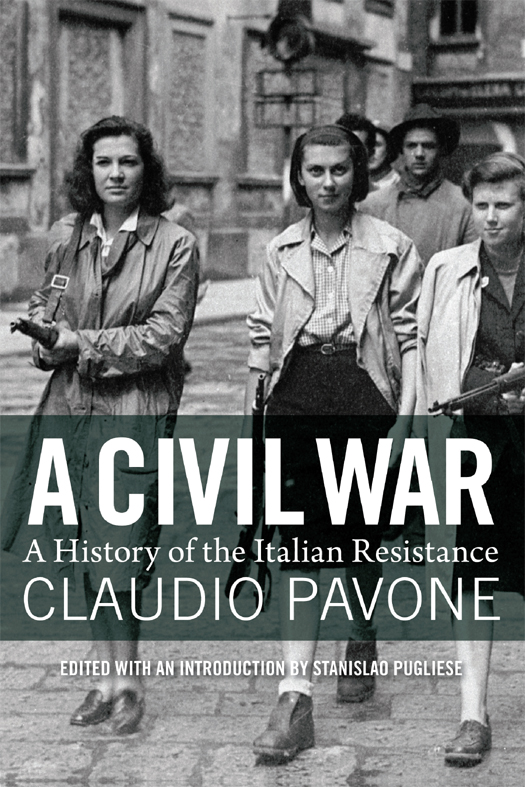oleebook.com
A Civil War: A History of the Italian Resistance de Pavone, Claudio
de Pavone, Claudio - Género: English
Sinopsis
A Civil War is a history of the wartime Italian Resistance, recounted by a historian who took part in the struggle against Mussolini's Fascist Republic. Since its publication in Italy, Claudio Pavone's masterwork has become indispensable to anyone seeking to understand this period and its continuing importance for the nation's identity.
Pavone casts a sober eye on his protagonists' ethical and ideological motivations. He uncovers a multilayered conflict, in which class antagonisms, patriotism and political ideals all played a part. A clear understanding of this complexity allows him to explain many details of the post-war transition, as well as the legacy of the Resistance for modern Italy. In addition to being a monumental work of scholarship, A Civil War is a folk history, capturing events, personalities
and attitudes that were on the verge of slipping entirely out of recollection to the detriment of Italy's understanding of itself and its...
Libros Recomendados - Relacionados
Reseñas Varias sobre este libro
Claudio Pavone's book is generally thought of as the most important work of Italian history and historiography of his generation. The title is deliberately provocative, an answer to those far-right historians who have sought to relativise the Italian resistance by recasting it as a civil war between a legitimate government (the Nazi-Fascists) and a group of rebels who chose to overthrow it - Pavone sees it as a 'civil war' in a very different sense, and deliberately reclaims the phrase in order to frame his complex discussion of moral choice in a moment of historical crisis, when legitimate sources of authority had collapsed and disappeared. A Civil War synthesises a huge body of research, writing, contemporary documentation and literature to analyse the various 'wars' that different Italians were fighting, morally, politically and ideologically speaking, when they took the decision to resist. But it goes beyond review to offer a balanced and illuminating analysis. This is one of those works of non-fiction so good that it manages to be both scrupulously specific and rigorous to its subject-matter, and yet also to transcend that subject-matter and become a book about the complexities of human life in general, which speaks particularly powerfully to our time. It's long and the arguments are complex, but couldn't come more highly recommended. Peter Levy's translation is excellent. Five stars.social-history7 s Owen HatherleyAuthor 43 books356
Hefty, dense and impressive book not so much on the what and when of the partisan war but on why people fought (on both sides) and how they saw their struggle, written very much from the left but very distant from the lectures and 'what ifs' of sect history. 3 s Rhuff338 17
Some reviewers seem to have wanted just another WW II book. But in this monumental work Professor Claudio Pavone captures the torn spirit of the physically and psychologically ravaged Italy of the 1940s. What did resistance mean: only the physical removal of Mussolini, in collaboration with patriotic moderate Fascisti General Badoglio? The restoration of Crown and parliament, purged of the Fascist era and its personnel? Or a new world altogether, rising from the rubble of shredded cities and the discredited social order that had built them? On these questions hinged the fate of the postwar world; and not just in Italy. As the participants themselves guerrilla partisans, party leaders, memoirists - wrote during the struggle itself:
A complete engagement of the masses, and one coming at the present time, even if it be for the purpose of the anti-German war would liberate new energies, the developments of which would be hard to foresee, but without doubt contrary to the present interests of order and property. (p. 465.) Speaking of a world and a future society that would put an end once and for all to all the acts of oppression, injustices and privileges of the ruling classes, that is to say all those evils which for centuries have afflicted the populations of our country. (p. 446.) Demanding a radical renewal of national life which the utter ruin of the country demands (p. 673) in tomorrows work of ordering the nation on new bases. (p. 468.)
What will the world that will come out of the torment of today be? asked a female partisan veteran, quoted on p. 686. I fear this tomorrow that will be so different, so hostile possibly to too many things I have believed in. I realise that that is how it must be; I am ready to give my life to ensure that it will be that; but will I have the strength to live in it, in this new order of tomorrow? Others certainly answered in the negative, most especially the Christian Democrats, influenced by fear that the civil war would swing in favour of the left and degenerate into revolution. (p. 303.)
Especially so as the Communists not just formal party members, but all those emotionally defining themselves as red were in the vanguard of the resistance. All those expecting a New World in the ashes of the Old were looking East, not West: it was the Socialist newspaper Avanti! which offered: If Italy gets bogged down in conformism it will be an Anglo-American colony whose lot it will be to grow old on the crumbs of the decomposing capitalistic economy. If it aligns itself with the revolutionary countries, marching at the head of which is the Soviet Union, it will regain its joy in living the creative effort of a new civilization. (p. 251.)
To allay these apprehensions the Communist Party itself pursued its United Front policy of self-effacement, reassuring the hesitant middle classes the resistance movement in no way means a socialist, but a democratic, revolution. (p. 479.) This was the line enforced by General Secretary Palmiro Togliatti, with the complete agreement and even insistence of Stalin. Yet such assurances carried little weight while the rank and file fought on under the promise that the shape of things today will change tomorrow. (p. 478.) When Party leaders spoke of preparing the men and the ground for the accomplishment of our social and economic plan (p. 479); that the essential thing is never to speak of being revolutionaries, but to be so in reality, without saying so (p. 479); what were non-Communists to think but that the present shape of things democratic unity is nothing but deception. (p. 478.)
These lengthy quotes clearly show the emergence of the new Cold War in the belly of the old hot one. This meant more than fear of Soviet military expansionism, or Communist conspiracies those tropes by which renewed Western military budgets and mass conformity were sold in America and Britain. The fear of civil war was real. Western goals were to preserve the old world, of business as usual, stripped of its Fascist and Nazi uniforms and refitted in new Democratic clothes, purged of extremes and propped by the Marshal Plan, then NATO, to ensure Italy and Europe did not relapse into Weimarism. If this meant quiet alignment with the just-defeated Fascists and Nazis, their appeasers and collaborators provided they remained properly former no matter their wartime behaviors, Christian Democrats could rationalize such reintegration in the spirit of Christian forgiveness rather than revenge. No doubt the recent memory of Mussolinis brutally ravaged and lynched corpse hanging by its heels, as a symbol of what a New World might bring, gave the Christian Democrats their edge at the polls in tandem with covert CIA skunkwork.
Professor Pavone has captured the spirit not only of that now far-away time, but of the world that shaped our own. Is it any better off for having so chosen? No doubt much of value was lost in the abandonment of wartime hope and ideals. Italy has never seen their again.3 s JosephAuthor 12 books14
A comprehensive social history of a pivotal period in Italian (and world) history. And with all too many countries today being torn by civil war and/or occupied by imperialist and repressive forces, with a great deal of contemporary resonance.
Weaknesses are occasional repetition, and the fact that is difficult for someone not intimately familiar with the concurrent milestones in political and military history to place the significance of dates. (There is a comprehensive timeline at the back, but flipping back & forth can be tiresome.) Worth taking your time with.1 Julien40 1 follower
Impressive book for anyone who is interested in the end of WWII in Italy which caused a violent civil war. However, the title is misleading: this is not a history but a description and an analysis of the main components of that civil war. It is difficult to read without a good knowledge of the historical context and more specifically of Italian political movements in the 20s, 30s and 40s. world-war-ii1 Federico Nemmi59 1 follower
Questo è un libro bello, terso, limpido. Piacevole da leggere ed allo stesso tempo difficile da digerire. Parlando della moralità della resistenza, parla della moralità, della politica, delle scelte in ogni tempo. Anche il tempo presente. A costo di scrivere un cliché, questo è un libro che andrebbe letto nelle scuole.history italiano1 Luca109
Autor del comentario:
=================================












